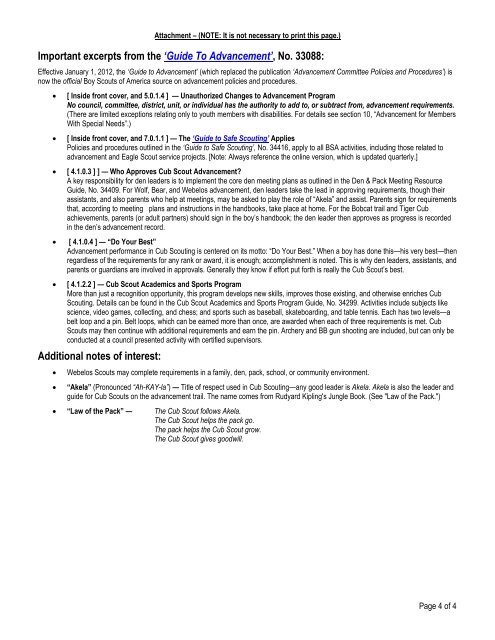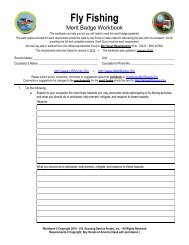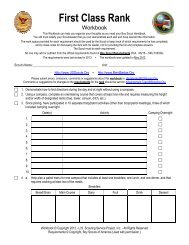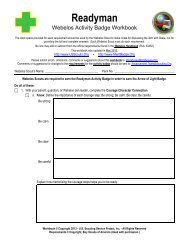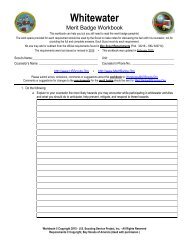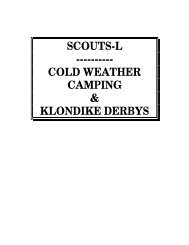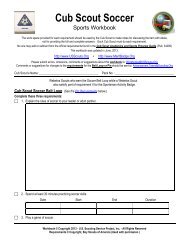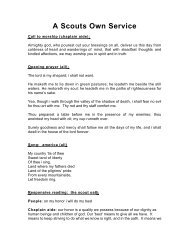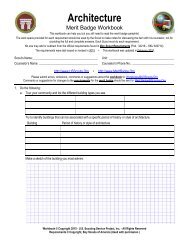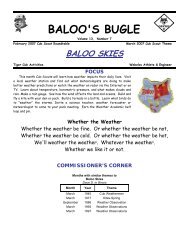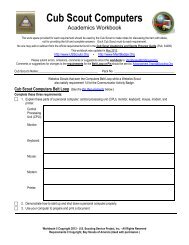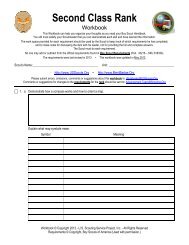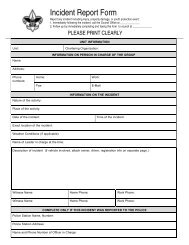Scientist worksheet - Merit Badge Research Center
Scientist worksheet - Merit Badge Research Center
Scientist worksheet - Merit Badge Research Center
- No tags were found...
You also want an ePaper? Increase the reach of your titles
YUMPU automatically turns print PDFs into web optimized ePapers that Google loves.
Attachment – (NOTE: It is not necessary to print this page.)Important excerpts from the ‘Guide To Advancement’, No. 33088:Effective January 1, 2012, the ‘Guide to Advancement’ (which replaced the publication ‘Advancement Committee Policies and Procedures’) isnow the official Boy Scouts of America source on advancement policies and procedures.[ Inside front cover, and 5.0.1.4 ] — Unauthorized Changes to Advancement ProgramNo council, committee, district, unit, or individual has the authority to add to, or subtract from, advancement requirements.(There are limited exceptions relating only to youth members with disabilities. For details see section 10, “Advancement for MembersWith Special Needs”.)[ Inside front cover, and 7.0.1.1 ] — The ‘Guide to Safe Scouting’ AppliesPolicies and procedures outlined in the ‘Guide to Safe Scouting’, No. 34416, apply to all BSA activities, including those related toadvancement and Eagle Scout service projects. [Note: Always reference the online version, which is updated quarterly.][ 4.1.0.3 ] ] — Who Approves Cub Scout Advancement?A key responsibility for den leaders is to implement the core den meeting plans as outlined in the Den & Pack Meeting ResourceGuide, No. 34409. For Wolf, Bear, and Webelos advancement, den leaders take the lead in approving requirements, though theirassistants, and also parents who help at meetings, may be asked to play the role of “Akela” and assist. Parents sign for requirementsthat, according to meeting plans and instructions in the handbooks, take place at home. For the Bobcat trail and Tiger Cubachievements, parents (or adult partners) should sign in the boy’s handbook; the den leader then approves as progress is recordedin the den’s advancement record.[ 4.1.0.4 ] — “Do Your Best”Advancement performance in Cub Scouting is centered on its motto: “Do Your Best.” When a boy has done this—his very best—thenregardless of the requirements for any rank or award, it is enough; accomplishment is noted. This is why den leaders, assistants, andparents or guardians are involved in approvals. Generally they know if effort put forth is really the Cub Scout’s best.[ 4.1.2.2 ] — Cub Scout Academics and Sports ProgramMore than just a recognition opportunity, this program develops new skills, improves those existing, and otherwise enriches CubScouting. Details can be found in the Cub Scout Academics and Sports Program Guide, No. 34299. Activities include subjects likescience, video games, collecting, and chess; and sports such as baseball, skateboarding, and table tennis. Each has two levels—abelt loop and a pin. Belt loops, which can be earned more than once, are awarded when each of three requirements is met. CubScouts may then continue with additional requirements and earn the pin. Archery and BB gun shooting are included, but can only beconducted at a council presented activity with certified supervisors.Additional notes of interest:Webelos Scouts may complete requirements in a family, den, pack, school, or community environment.“Akela” (Pronounced “Ah-KAY-la”) — Title of respect used in Cub Scouting—any good leader is Akela. Akela is also the leader andguide for Cub Scouts on the advancement trail. The name comes from Rudyard Kipling's Jungle Book. (See "Law of the Pack.") “Law of the Pack” — The Cub Scout follows Akela.The Cub Scout helps the pack go.The pack helps the Cub Scout grow.The Cub Scout gives goodwill.Page 4 of 4


